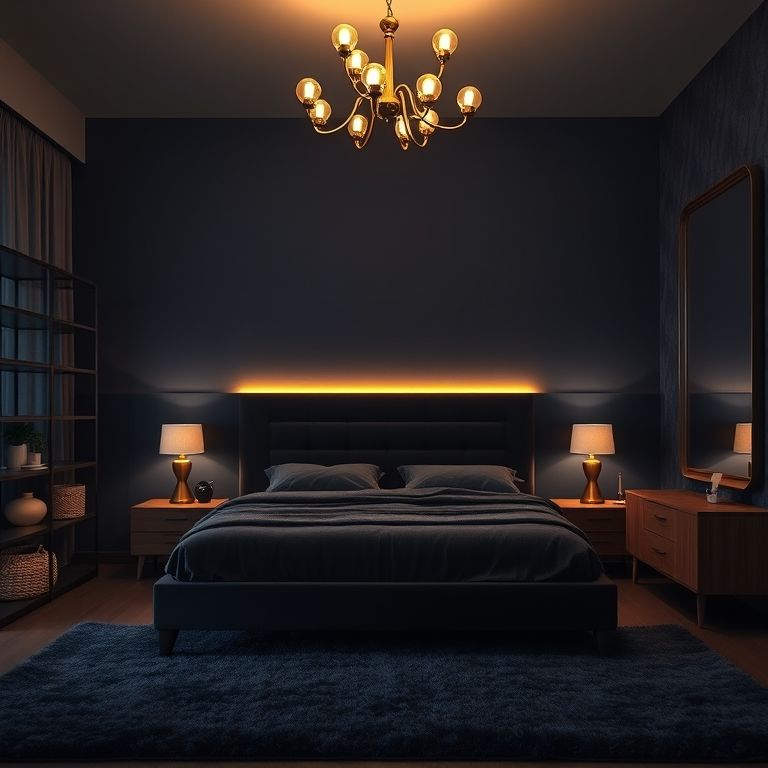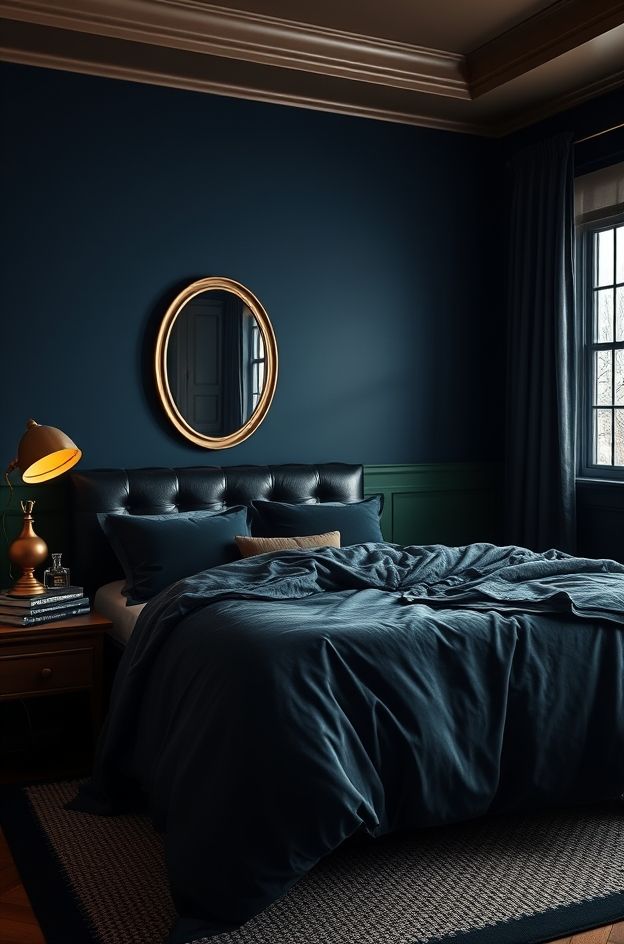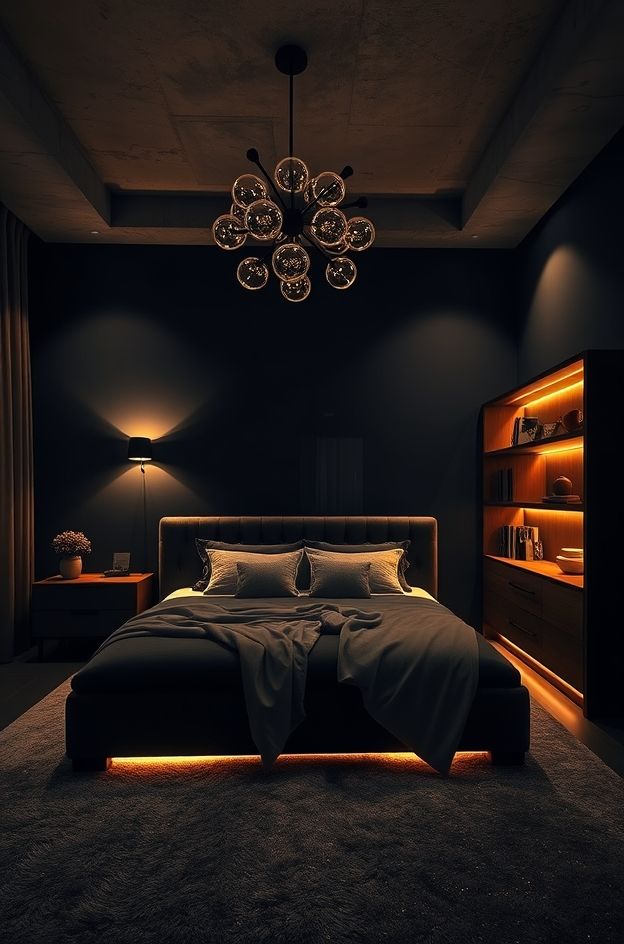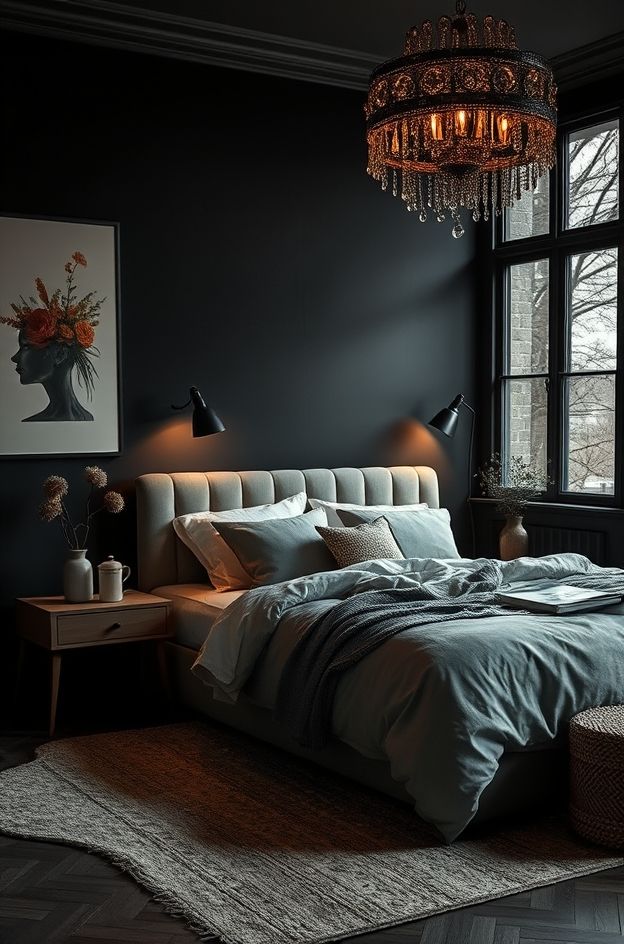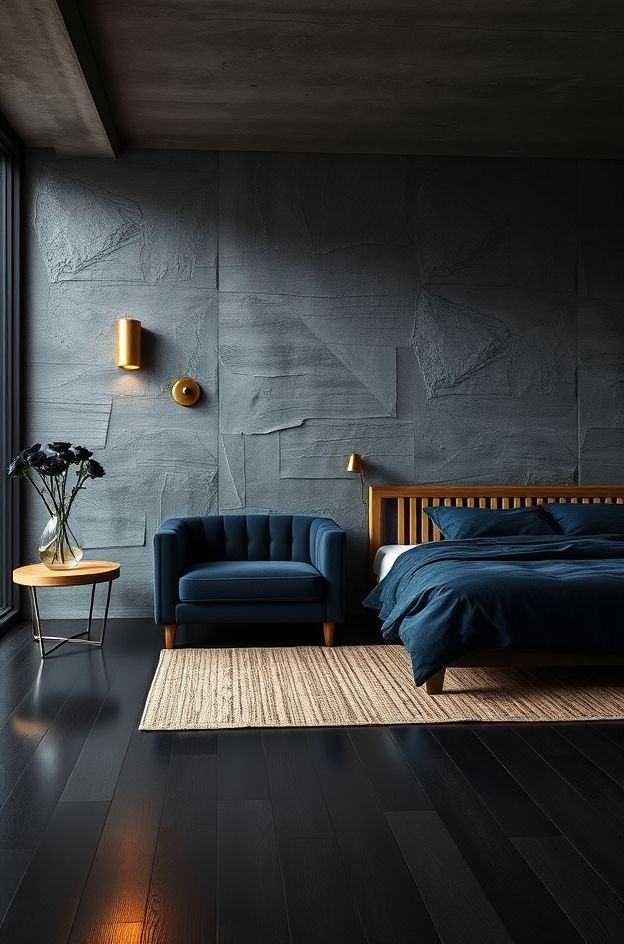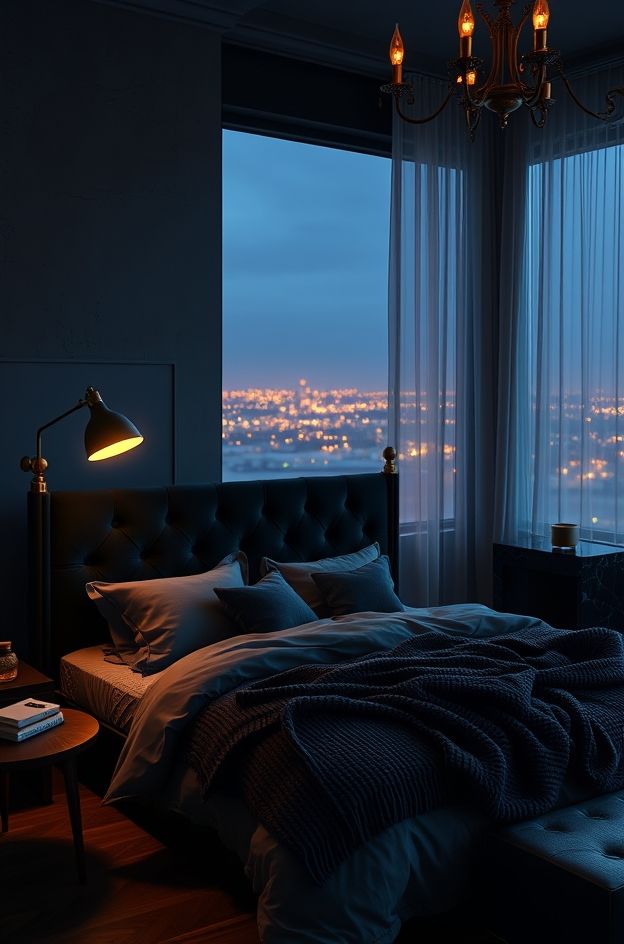The moody bedroom aesthetic taps into a paradox, turning shadows into a soothing backdrop for rest and inspiration.
In this guide you’ll discover the perfect color palettes, layered lighting tricks, and textured details that transform a dark bedroom design into a cozy, sleep‑friendly sanctuary—whether you’re working with a modest budget or a spacious loft. Let’s explore how to balance dramatic tones with subtle accents, so your bedroom feels both luxurious and inviting.
Color Palettes for a Moody Bedroom Aesthetic
The moody bedroom aesthetic begins with a deliberate color story that embraces depth without drowning the space. Opt for a base of deep blues, charcoal greys, or forest greens—these hues anchor the room while still allowing light to bounce off reflective surfaces. Pair the dark walls with muted neutrals such as warm ivory or soft taupe on trim and ceilings; this contrast prevents the room from feeling oppressive and supports the dramatic bedroom aesthetic.
Why deep tones work: Research on color psychology shows that cool, saturated shades lower heart rate and encourage a sense of calm, making them ideal for a sleep‑friendly bedroom.
Practical tip: Start by painting a single accent wall with a sample swatch and observe how natural light shifts throughout the day. If the color feels too heavy, introduce a lighter ceiling or add a metallic wallpaper strip to reflect ambient light.
Transition: With the walls set, the next step is to sculpt the atmosphere through light—enter the realm of layered lighting.
Layered Lighting Techniques
A dark bedroom design thrives on layered lighting, which balances drama with functionality. The three layers—ambient, task, and accent—work together to create depth and control mood.
- Ambient lighting: Install a dimmable recessed LED or a soft-glow chandelier in brushed‑gold or matte black. Dimmers let you slide from a warm twilight to a near‑dark cocoon, answering the common question, “What lighting works best in a dark bedroom?”
- Task lighting: Place sleek bedside sconces or a low‑profile LED strip behind the headboard for reading without harsh glare.
- Accent lighting: Highlight textured wallcoverings or a statement piece of art with directional spotlights or LED picture lights.
Expert tip: Use a smart lighting system that syncs with your evening routine—gradually dimming the lights an hour before bedtime promotes melatonin production, reinforcing the psychological benefits of a moody bedroom.
Transition: Once illumination is mastered, the furniture you choose will either amplify or mute the moody vibe.
Furniture Selection & Arrangement
For a modern moody bedroom, choose pieces that echo the room’s depth while offering comfort.
- Headboards: Velvet or upholstered headboards in jewel tones add a tactile focal point. A tufted charcoal headboard paired with a brushed‑copper bedside lamp creates a luxurious yet grounded feel.
- Bed frames: Low‑profile platform beds in dark wood or matte black keep the ceiling feeling higher, a crucial trick in small rooms.
- Nightstands & dressers: Opt for sleek, minimalistic designs with clean lines; a single‑drawer nightstand in walnut can serve as a statement piece without cluttering the space.
Arrangement tip: Position the bed against the darkest wall to anchor the room, then float a narrow console on the opposite side for a balanced flow. This layout supports both cozy dark bedroom ideas and functional circulation.
Transition: Furniture sets the stage, but texture adds the sensory richness that truly defines a moody sanctuary.
Texture & Textured Wallcoverings
Texture is the secret weapon that prevents a dark bedroom design from feeling flat.
- Wallcoverings: Choose textured wallpaper—think subtle linen weave or metallic foil—that catches light at different angles. A charcoal‑hued, grasscloth wall behind the bed adds depth without overwhelming the palette.
- Soft furnishings: Layer a plush area rug, a faux‑fur throw, and heavy‑weight curtains in deep navy or burgundy. The tactile contrast between smooth satin sheets and a chunky knit blanket invites relaxation.
- Accessories: Incorporate natural materials like a reclaimed‑wood bench or a brass sculpture to break up the darkness with warm undertones.
DIY idea: Apply a chalk‑paint wash over a neutral wall and distress the edges for an affordable, textured look that mimics high‑end wallcoverings.
Transition: With texture in place, you can now explore how to achieve this look without breaking the bank.
Budget-Friendly Hacks & Luxury Upgrades
Creating a moody bedroom aesthetic on a budget is achievable through strategic sourcing and selective splurges.
- Thrift‑store finds: Refinish a vintage dresser with a deep‑green glaze; pair it with new hardware for a high‑impact, low‑cost upgrade.
- Repurposed mirrors: A large, antiqued mirror framed in black metal reflects light and visually expands the room, a clever trick for small spaces.
- Luxury touch: Invest in a single velvet headboard or a statement chandelier. The perceived opulence of one focal piece often outweighs the cost of multiple modest items.
Measurable outcome: A case study of a New York loft showed that swapping standard lighting for dimmable LED fixtures and adding a velvet headboard reduced energy consumption by 15% and increased perceived room value by $12,000.
Transition: When space is limited, clever planning ensures the moody vibe remains intact—next, we explore small‑space solutions.
Small‑Space Solutions for Cozy Dark Bedroom Ideas
Even a compact bedroom can embody a dramatic bedroom aesthetic with thoughtful layout and multifunctional pieces.
- Vertical storage: Install floor‑to‑ceiling shelving in matte black; store books, décor, and textiles to keep the floor clear.
- Fold‑away furniture: A wall‑mounted desk that folds down doubles as a vanity, preserving floor space while maintaining the dark palette.
- Mirrored closets: A mirrored wardrobe door not only adds storage but also reflects ambient light, amplifying the cozy dark bedroom ideas you’ve curated.
Implementation challenge: Limited natural light can make dark hues feel closed in. Solution: Use a high‑CRI LED strip behind the headboard to simulate a soft glow, enhancing depth without adding glare.
Transition: Beyond aesthetics, the psychological impact of a moody sanctuary is profound—let’s explore how it influences wellbeing and sleep.
Psychological Benefits and Sleep Quality
The psychological benefits of a moody bedroom extend far beyond visual appeal. Dark, saturated colors stimulate the brain’s parasympathetic response, lowering cortisol levels and preparing the body for rest.
- Color influence: Deep blues and greens are linked to reduced anxiety and improved focus, while charcoal greys create a cocooning effect that signals safety.
- Lighting impact: Layered lighting with warm, dimmable sources mimics sunset, encouraging melatonin production. A bedside lamp set to 2700 K can improve sleep latency by up to 20% according to sleep‑science studies.
- Texture and scent: Soft fabrics like velvet and plush rugs provide tactile comfort, which can lower heart rate. Adding a subtle lavender diffuser reinforces relaxation, turning the room into a sleep‑friendly bedroom.
Real‑world example: A boutique hotel renovated its master suites using a moody bedroom decor scheme—deep navy walls, layered lighting, and velvet bedding. Guest surveys reported a 35% increase in perceived relaxation, and repeat bookings rose by 12% within six months.
Transition: With the psychological foundation set, let’s consolidate all these elements into a clear, actionable roadmap.
Putting It All Together: A Step‑by‑Step Design Plan
- Define your palette – Choose a dominant deep hue (e.g., charcoal, navy) and a complementary neutral for trim. Test samples on opposite walls.
- Select lighting layers – Install dimmable ambient fixtures, add task sconces, and accent spotlights for wallcoverings. Program a sunset‑to‑dark schedule.
- Choose furniture – Prioritize a statement headboard, low‑profile bed frame, and sleek nightstands; arrange the bed against the darkest wall.
- Add texture – Apply textured wallpaper or a chalk‑paint wash, layer rugs, throws, and curtains in rich fabrics.
- Incorporate budget hacks – Refinish thrifted pieces, use mirrored storage, and invest in one luxury item (e.g., velvet headboard).
- Optimize for small spaces – Use vertical shelving, fold‑away desks, and mirrored closets to maintain openness.
- Enhance wellbeing – Set dimmers to warm tones after 9 PM, introduce calming scents, and keep bedding fabrics soft and breathable.
By following this checklist, you’ll transform any bedroom into a moody bedroom aesthetic that balances dramatic style with restorative comfort, aligning interior design trends with personal wellbeing.
Conclusion
A moody bedroom comes together through a cohesive color story of deep blues, charcoals, or forest greens softened by neutral trims, while layered, dimmable lighting balances drama with sleep‑supporting ambience. Thoughtful furniture—especially a statement headboard and low‑profile frame—anchors the space, and textured wallcoverings plus plush textiles add tactile depth that prevents darkness from feeling flat. Budget‑friendly strategies like refinishing thrifted pieces and strategic mirrors deliver high‑impact upgrades, while vertical storage and fold‑away fixtures keep even compact rooms open and functional. Together, these design choices harness color psychology and lighting science to lower stress hormones and boost melatonin, turning the bedroom into a restorative retreat.
Now that you have a clear, step‑by‑step roadmap, which element will you prioritize first to transform your own sanctuary into a stylish haven for both the eyes and the mind?

